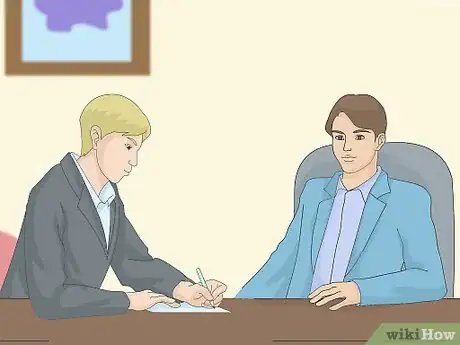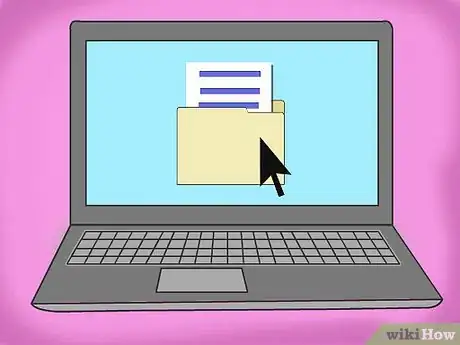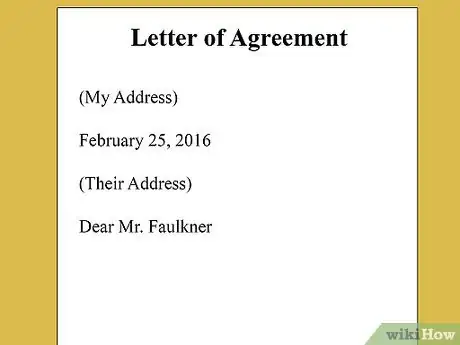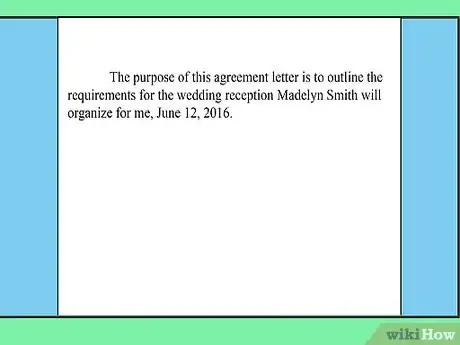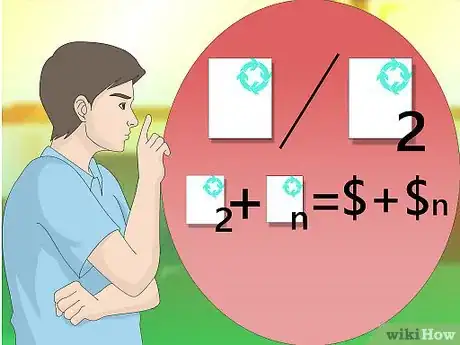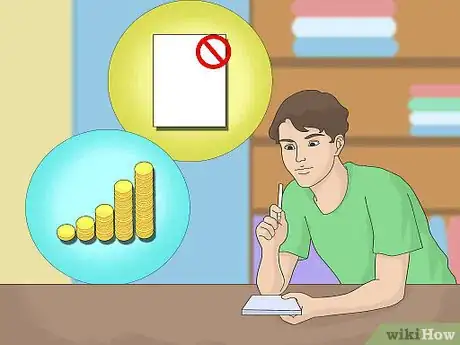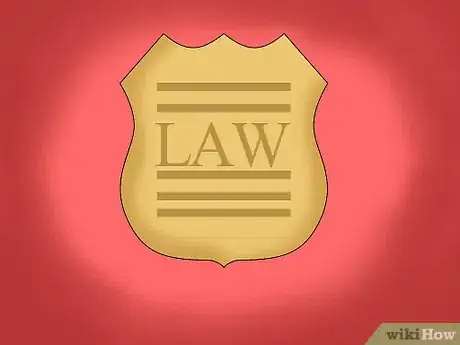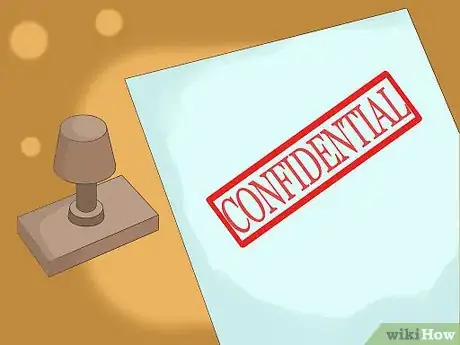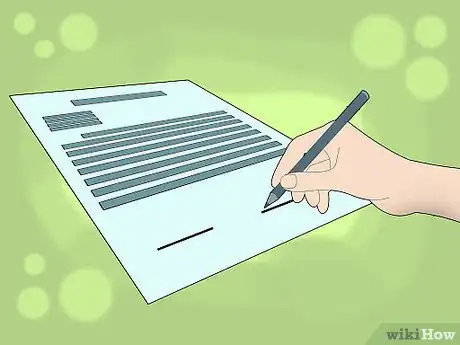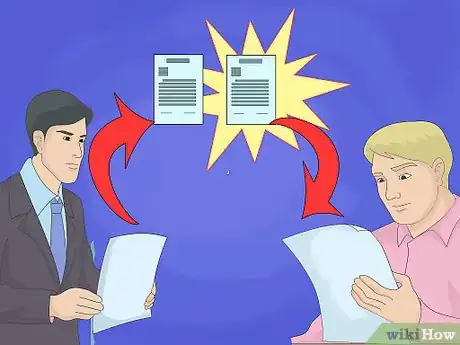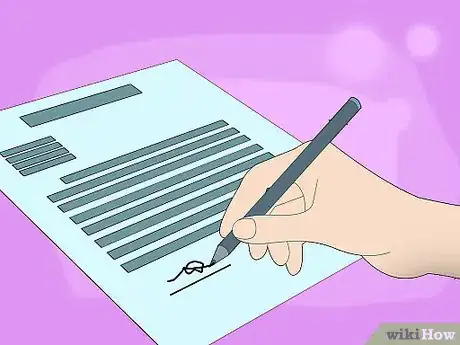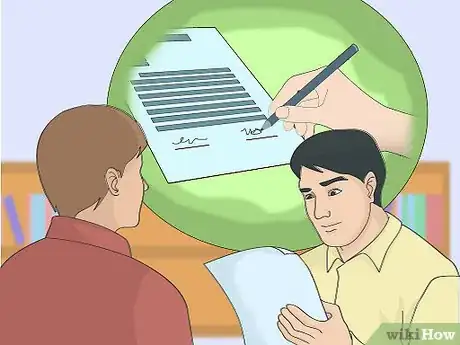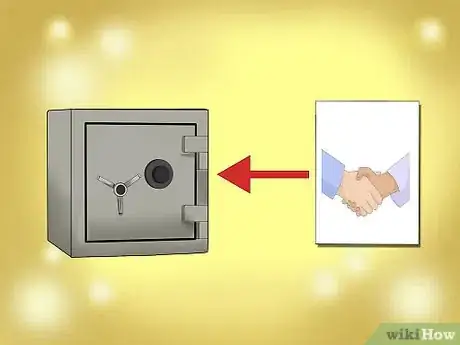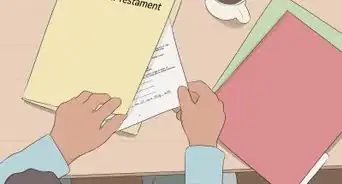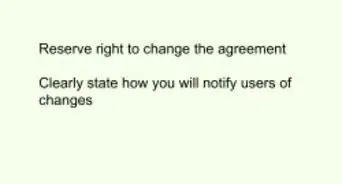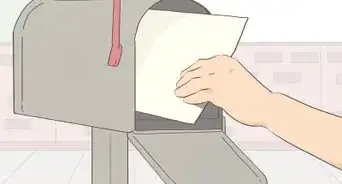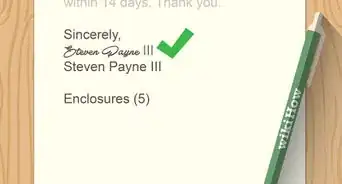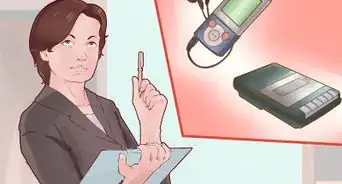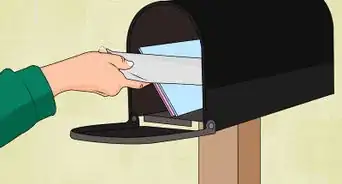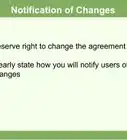This article was co-authored by Clinton M. Sandvick, JD, PhD. Clinton M. Sandvick worked as a civil litigator in California for over 7 years. He received his JD from the University of Wisconsin-Madison in 1998 and his PhD in American History from the University of Oregon in 2013.
This article has been viewed 168,847 times.
Agreement letters can be written for a variety of purposes. One common reason people need agreement letters is when they have orally agreed to perform work for someone and want a written agreement of the terms. There is no one way to write an agreement letter.[1] However, you should include basic information such as the nature of the agreement, deadlines, and terms of payment.
Steps
Reaching an Agreement
-
1Talk with the other party. Before drafting an agreement letter, you need to know what you and the other person agree to. You should sit down and talk, whether in person or over the phone. Take notes so that you can remember the terms of the agreement.
- Try to come to as much agreement as possible. An agreement letter can be less formal than a contract. However, it needs to be sufficiently definite so that both parties understand what is expected.
-
2Negotiate. You might be anxious to start a new project but be unhappy with some of the terms the other party is offering, e.g., the amount of pay or the short deadlines. You can try to negotiate with the other party.
- To successfully negotiate, you should be prepared to give something away to get something in return.[2] For example, if you want a little more money for the project, then agree to an extra round of revisions. Or if you want to lower the overall cost of the project, then offer to pay more upfront.
Advertisement -
3Outline the letter. Before typing up the agreement letter, you should outline it. Look at your notes and try to organize the information in a meaningful manner. The outline for an agreement letter can look like this:
- the nature of the agreed upon work
- deadlines
- terms of payment (how much, method of payment, etc.)
- when the agreement begins and ends
- other details
Drafting the Agreement Letter
-
1Open a word processing document. You should type your agreement letter. Set the font to a readable size and style. For example, Times New Roman 12 point is fairly standard. Choose whatever looks comfortable.
- If you have letterhead, then you should use it when you print off the agreement letter. Be sure to space down five or six lines so that the letter doesn’t print over the letterhead.
-
2Title the letter. At the very top of the page, you should place the words “Letter of Agreement” in bold. Center the text.[3]
-
3Include the date and addresses. You will write your letter like a regular business letter. Make sure that the date and the other person’s address are lined up on the left-hand margin.
-
4Explain the letter’s purpose. In the first paragraph, you should state why you are writing the agreement letter.[6] For example, you could write, “The purpose of this agreement letter is to outline the requirements for the wedding reception Madelyn Smith will organize for me, June 12, 2016.”
-
5Define the work to be performed. In as much detail as possible, the letter should outline the tasks to be performed. For example, if someone is to write a rough draft of a book, then you would want to state the subject matter of the book, its length, and the theme of the book.
- If you are hiring someone to plan a wedding, then you would want to list what the event planner should do. For example: hire a band, coordinate with a florist, provide one meal for 55 guests, and rent the reception hall.
-
6Identify benchmarks and timelines. In as much detail as possible, explain any benchmarks or timelines. If you want to see a rough draft of a document, state when it is due.[7] If you want the other party to make progress reports to you, then list the dates that the reports should be submitted.
- For example, you could state, “Quarterly status reports will be made as follows: April 1; June 30; and September 30. The final draft should be submitted no later than December 31, 2016. These deadlines can be amended by the signed written agreement of the parties.”
-
7Agree on revisions. If the agreement involves creative works (writing, artwork, music, etc.), then you might want to come to an agreement about how revisions will be handled. Revisions can sometimes cause conflict, because one party might find the number of revisions excessive. Explain the revision process.
- For example, you could state, “Revisions may be made by the artist only after completion of the first mock-up. Once the client has approved of the mock-up, additional fees will be charged for revisions made after this fact.”
- You can also state the number of revisions. For example, you could state, “The maximum number of free revisions is two. If client wants more, then client will be charged additional fees.”
-
8Include payment information. You will want to include information about how much you will be paid, but also when payment must be made. You should also state how much must be paid upfront, if anything.
- For example, the letter could say, “A sum of $1,000 will be paid to Mr. Jones within five business days of signing this agreement. Mr. Jones will bill the balance for the project at the completion date (tentatively June 1, 2016) and payment in full will fall due within 14 business days.”[8]
- Also include a clause on cancellation. The other party might want to cancel before you have completed the project. In this case, you will need to explain how much they will owe for partial work. For example, you could write, “Cancellation fees will be calculated as follows: 50% of the final fee is due within 15 business days if the project is cancelled for any reason before completion. One hundred percent (100%) of the total fee is due despite cancellation if the project has been completed.”
-
9Clarify how long the agreement is in force. If it is not apparent from the rest of the letter, then you should specify how long the agreement is in effect for. For example, if you are establishing a continuing work relationship in the letter, then set the end date.
- You could state, “This agreement comes into effect January 1, 2016. It will expire December 31, 2016. At that point, both parties will consider whether to extend the agreement.”
-
10State the governing law. Just as you would in a contract, you should state which law governs the agreement in case there is a dispute.
- Sample language might read, “This Agreement will be governed by the law of the state of Texas.”
-
11Add a non-disclosure provision, if necessary. If the parties are trading or using confidential information, then you will want to add a non-disclosure provision. Confidential information includes trade secrets, patented materials, or customer lists.
- A typical non-disclosure clause might read, “The parties agree that in their performance under this letter all intellectual property or information marked as confidential will be handled with the standard of care normally given to confidential information.”
-
12State the letter contains the entire agreement. If the letter serves as the final agreement, then you will want to make that known. However, if the letter only contains some of the agreements between you and the other party, then you shouldn’t add this clause.
- You could write, “This letter contains the entire agreement between the parties with respect to the subject matter. No promise or condition not contained in the letter is binding. If any term is held invalid or unenforceable, then the remainder of the agreement should remain in effect. No modification of this agreement shall be valid unless made in writing and signed by both parties.”
-
13Include a signature block. Both you and the other party should sign the letter. Make two signature blocks, one for each party. Type your name under the signature line and create another line beneath the signature line for the date.
- Just above the signature block type the words “Understood and Agreed.”[9]
Finalizing the Letter
-
1Send a rough draft to the other party. You should send a copy to the other party to review. If you are expecting them to sign the letter, then you need to give them a chance to object to anything in the agreement. It is better that the other party offer suggestions for revisions than to scrawl all over the letter, striking out sentences and writing other sentences in.
- Give the other party a week to review the letter and return it to you with corrections. You will then type up a new master letter.
- If you don’t agree with suggested corrections, then call the other party and discuss your disagreement. You cannot sign a letter unless you both agree to the contents contained in it.
-
2Sign the letter. Once you come to an agreement, print off the letter and sign it, using black ink. Add the date. Keep a copy of the letter for your records.
-
3Ask for the other party’s signature. Mail the revised letter to the other party and include a note asking the other party to sign and return the original to you.[10]
- Mail the letter certified mail, return receipt requested. This way, you will know that it was received.
- Also include a copy of the letter in the envelope for the other party’s records.
-
4Store your copy safely. When you get the signed letter returned, be sure to store it safely where it won’t be damaged. You may need to rely on the agreement letter should a dispute arise between you and the other party. The letter could serve as evidence in a lawsuit, for example.
References
- ↑ http://www.writersplace.org/sample-letter-of-agreement/
- ↑ http://www.entrepreneur.com/article/203168
- ↑ https://www.rocketlawyer.com/document/letter-of-agreement.rl
- ↑ https://writing.wisc.edu/Handbook/BusinessLetter.html
- ↑ http://www.writersplace.org/sample-letter-of-agreement/
- ↑ http://www.writersplace.org/sample-letter-of-agreement/
- ↑ http://www.writersplace.org/sample-letter-of-agreement/
- ↑ http://www.writersplace.org/sample-letter-of-agreement/
- ↑ http://www.the-efa.org/res/sample_agreement.php
About This Article
To write an agreement letter, start by titling your document "Letter of Agreement" in bold, centered text, then add your address, the date, and the other party's address. After a salutation like, "Dear Ms. Jones," explain the purpose of your letter and follow that with a detailed outline of the tasks to be performed, including important deadlines. Also, make sure to mention how much you'll be paid, when you'll be paid, and how long the agreement will be in effect. In case there is a dispute later, be sure to include a cancellation clause and state which laws govern the letter by writing something like, "This Agreement will be governed by the law of the state of Texas." Finally, state that the letter contains the entire agreement and sign it to make it official. For more tips from our Legal co-author, like how to finalize your agreement letter, read on!
